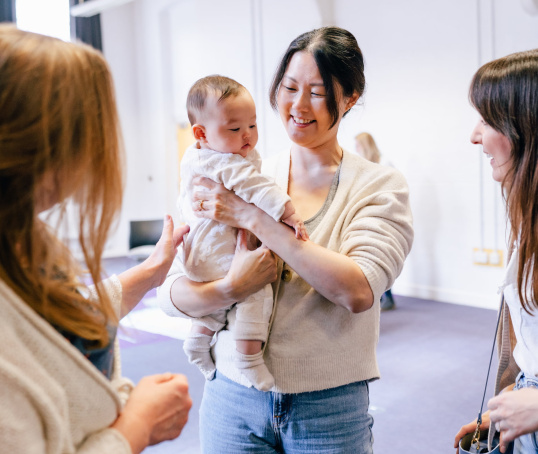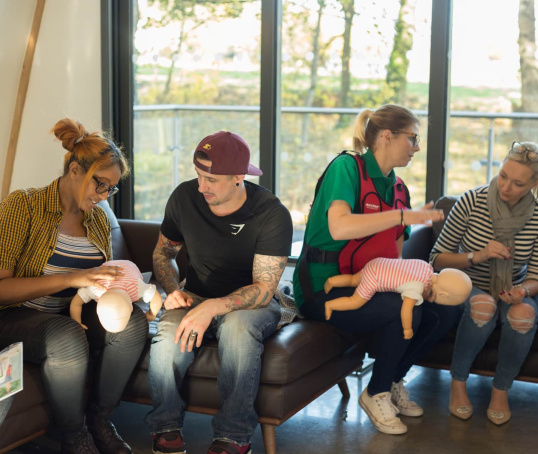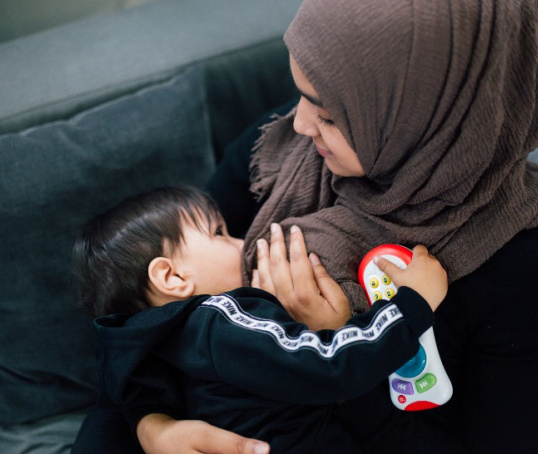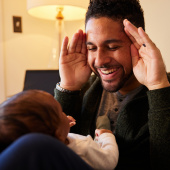Sleep is a topic close to new parents’ hearts. Understanding what makes a place safe to sleep is key. Here we explain what’s recommended, what’s not, and what you may need to buy.
Where should I put my newborn to sleep?
The safest place for a baby to sleep is in the same room as their caregiver. This should be for at least the first six months, both day and night. There are no devices on the market that can replace a parent or carer being in the same room (Lullaby Trust, no date a).
A separate sleep space is considered safest, with the baby on their back on a firm, flat and clear surface (Lullaby Trust, no date a).
This guidance is to reduce the risk of Sudden Infant Death Syndrome (SIDS).
What do we need to buy?
You’ll need a safe place for your baby to sleep during the day and at night. Whatever you’re using, read the manufacturer’s instructions and make sure you’re using the sleep space correctly. You could use a:
Cot
A fixed sleeping surface that will suit the child up until they’re older. Usually made from wooden slats. The Royal Society for Prevention of Accidents (RoSPA) recommend it meets British safety standard BSEN716, and the vertical slats are no more than 6.5cm apart.
Cots made before 1973 may have lead based paint, which is toxic (RoSPA, no date).
Moses basket
A portable sleeping surface, smaller than a cot, usually made from woven natural fibres. This is handy for keeping the baby near for daytime naps.
Crib
A small sleeping surface, often on a stand. This might be made of natural fibres or fabric. The safety standard to look for is EN1130.
Sidecar crib or bedside cot
That attaches to the side of an adult bed (make sure there are no gaps and any drop-side mechanism works properly) (RoSPA, no date).
What about Baby Boxes?
There is no evidence that Baby Boxes reduce the risk of SIDS. It is recommended to use a sleeping space listed above that is covered by a safety standard (Reid, 2020).
Can I use a pod or nest?
Pods or nests are not recommended, as they are a risk for overheating and suffocation (Lullaby Trust, no date e).
What bedding do we need?
Mattress
The mattress should (Lullaby Trust, no date e):
- be in good condition, with no rips, tears, or water damage
- be firm and flat, with no parts with extra cushioning
- be protected with a waterproof cover
- fit the sleeping space properly
- have a fire-resistant label
The suggested link between second-hand mattresses and a higher chance of SIDS is unproven. If not possible to buy new then use the list above to be as safe as possible (Lullaby Trust, no date e).
Bedding
Bedding should be (Lullaby Trust, no date e; NHS Start for Life, no date):
- a firmly tucked in or fitted base sheet
- a lightweight blanket – cellular blankets keep the baby warm but allow air flow and reduce the chance of suffocation
- the blanket should be below shoulder height when the baby’s feet are at the foot of the sleeping area
- or a sleeping bag that fits the baby well
Baby sleeping bags should be snug enough that the baby can’t slide down so the fabric covers their face (Lullaby Trust, no date e). They come in various togs (NHS Start for Life, no date):
- A tog of 2.5 is suitable year-round for a room between 16 and 20°C.
- A tog of 1 is suitable for warmer months or a room between 20 and 24°C.
- A tog of 0.5 is suitable for hot weather or a room between 24 and 27°C
What about co-sleeping in the same bed?
Some people plan to fall asleep with their baby in bed – called bed-sharing, while others might unintentionally fall asleep with their baby in bed with them.
Sleeping in close contact helps babies settle and supports breastfeeding. Breastfeeding is protective against SIDS (UNICEF, 2019).
There are some situations when the recommendation is not to bed-share (NHS, 2021):
- SIDS is more common if parents smoke in pregnancy or after birth. So do not share a bed if you or your partner are smokers.
- Don’t bed-share if you or your partner have drunk more than two units of alcohol.
- Avoid bedsharing if either of you have taken drugs, or any medication that makes you sleepy.
- Don’t bed share if your baby weighed less than 2.5kg when they were born.
If you’re planning to bedshare, or know that it might happen (NHS, 2021):
- Make sure there are no pillows or duvets which might cover the baby's face or make them too warm.
- Check they can’t fall out of the bed, or get trapped against the wall.
- Keep other children and pets out of the bed.
- The baby should be on their back, not face down or on their side.
- Ensure the baby won’t overheat – a cooler room and light bedding are best.
- Watch our video on sharing a bed with your baby.
Never sleep on a sofa or armchair with your baby
Falling asleep on a sofa or armchair with your baby increases the risk of SIDS by 50 times. The baby may get trapped and be unable to breathe (Lullaby Trust, no date a).
If you’re sitting on a sofa or armchair with your baby and feel sleepy, move the baby. Place them on a firm, flat surface to sleep, like their cot or Moses basket. Co-sleeping in bed with your baby is safer than on an armchair or sofa (UNICEF, 2019).
What is SIDS?
Sudden Infant Death Syndrome (SIDS) is when a seemingly healthy baby under 12 months old dies unexpectedly. Most deaths happen within the first six months (NHS, 2021). SIDS is also known as cot death, though it can happen outside a cot.
In the UK, SIDS affects about 200 babies a year. The causes are unknown, but it is thought to be a combination of factors.
How do you protect against SIDS?
These recommendations help reduce the chance of SIDS (NHS, 2021; Lullaby Trust, no date b; Lullaby Trust, no date c; Lullaby Trust, no date e; Lullaby Trust, no date f):
- Put the baby on their back to sleep as a routine from day one. Sleeping on their side or front greatly increases the risk of SIDS.
- Babies who normally sleep on their back and sometimes sleep on their front are at a higher risk of SIDS.
- Once they can move themselves from their back to their front and back again by themselves, there is no need to worry. Carry on placing them on their back to sleep when putting them in their sleeping space.
- If a baby has fallen asleep in the car, take them out of their car seat and put them on a firm flat surface to sleep when you get to your destination.
- Put the baby to sleep in the same room as the parent or caregiver for the first six months – day and night. This form of co-sleeping is called room sharing.
- Don’t put a hat on the baby when inside as they might overheat.
- Use a sling or carrier safely.
- Don’t smoke in pregnancy, or let anyone smoke in the same room as the baby.
How can I keep the cot safe?
- Use a mattress that’s firm, flat and waterproof.
- Make sure there are no pillows, duvets or toys on the sleeping surface.
- Don't use cot bumpers as the baby could get caught up in the strings, or fall after pulling themselves up on the bumper.
- Put the baby’s feet at the foot of the cot, Moses basket, or crib so they can’t wriggle down under the bedding.
- Don’t tilt or prop up either the mattress or the sleeping surface. This doesn’t help with reflux or colds.
- Make sure the baby’s head can’t get covered by blankets.
What temperature should the room be?
The recommended temperature is between 16 and 20°C for babies. The Lullaby Trust recommend using a room thermometer (The Lullaby Trust, no date d).
To be sure this is right for your baby, feel the back of their neck or chest, and remove a layer if they are hot or sweaty. Babies do not need a hat when indoors (Lullaby Trust, no date d).
Don’t place the baby’s sleeping surface next to a radiator, heater or sunny window. Babies can’t regulate their temperature and could get too hot (RoSPA, no date).
Do we need a monitor?
There is no research showing that monitors prevent SIDS. They cannot replace your own supervision of your baby. If you choose to use one you should still use the safer sleep guidance (Lullaby Trust, no date g).
Any monitor you buy in the UK should have a certified medical device mark (CE or UKCA). This shows they have been tested and meet standards for medical devices sold in the UK (Lullaby Trust, no date g).
The Lullaby Trust recommends that movement devices should have ‘MD’ or ‘medical device’ on the manufacturer’s information (Lullaby Trust, no date g).
The Lullaby Trust offers more information about the different kinds of monitors on their website.
What equipment should we avoid or be aware of?
Avoid these items, which increase the risk of SIDS through overheating or suffocation (Lullaby Trust, no date e):
- Quilts or duvets
- Pillows - sometimes marketed as protecting against flat head syndrome
- Weighted swaddles, blankets or sleeping bags
- Sheepskin
- Toys in the sleeping area
- Cot bumpers, as infants can get tangled in the ties or fabric or fall after pulling themselves up on the bumper
- Hot water bottles or electric blankets
Other potential risks in the sleeping area include (RoSPA, no date):
- Blind cords can wrap around a baby’s neck and pose a strangulation risk. Avoid them in the baby’s bedroom or use blinds with a built-in cleat (a device to secure the cord). In other rooms wrap the cords out of the way using a cleat.
- Babies and toddlers might climb up drawers of a chest or wardrobe. If not fastened to the wall it could fall onto them.
- Ensure windows are locked or use a restrictor to allow air in while preventing them from opening fully.
- Keep nappy bags away from babies and young children. Even if it doesn’t go over the head, a bag can cover the face and stop the baby breathing.
Further information
Our NCT New Baby courses supports new parents and their babies, helping make the transition to parenthood a little bit easier.
Find your nearest baby bank at the Baby Bank Alliance.
The Lullaby Trust website has FAQs, and they also offer the Lullaby Trust Baby Check app. Their information is available in several languages.
The RoSPA child hub has information on general child safety.
BASIS (no date) Side-car cribs, bedside cots, and co-sleepers. https://www.basisonline.org.uk/side-car-cribs-bedside-cots-and-co-sleep… [20 Feb 25]
Lullaby Trust (no date a) Room sharing: where should my baby sleep? https://www.lullabytrust.org.uk/baby-safety/safer-sleep-information/roo… [20 Feb 25]
Lullaby Trust (no date b) Evidence base. https://www.lullabytrust.org.uk/research/evidence-base/ [20 Feb 25]
Lullaby Trust (no date c) The best sleeping position for babies. https://www.lullabytrust.org.uk/baby-safety/safer-sleep-information/sle… [20 Feb 25]
Lullaby Trust (no date d) Your baby’s room temperature. https://www.lullabytrust.org.uk/baby-safety/safer-sleep-information/roo… [20 Feb 25]
Lullaby Trust (no date e) Baby mattresses and bedding. https://www.lullabytrust.org.uk/baby-safety/baby-product-information/ma… [20 Feb 25]
Lullaby Trust (no date f) Choosing the best car seat for your baby. https://www.lullabytrust.org.uk/baby-safety/baby-product-information/ca… [19 Mar 25]
Lullaby Trust (no date g) Baby monitors. https://www.lullabytrust.org.uk/baby-safety/baby-product-information/ba… [17 Mar 25]
NHS (2021) Sudden Infant Death Syndrome (SIDS) https://www.nhs.uk/conditions/sudden-infant-death-syndrome-sids/ [20 Feb 25]
NHS Start for Life (no date) Safer sleep. https://www.nhs.uk/start-for-life/baby/baby-basics/newborn-and-baby-sle… [20 Feb 25]
Reid J (2020) The baby box – if used as sleep boxes may put baby’s life at risk. https://www.hud.ac.uk/news/2020/january/baby-box-dangers/ [17 Mar 25]
RoSPA (no date) Bedtime. https://www.rospa.com/resources/hubs/keeping-kids-safe-(1)/bedtime [20 Feb 25]
UNICEF (2019) Co-sleeping and SIDS: a guide for health professionals. https://www.unicef.org.uk/babyfriendly/baby-friendly-resources/sleep-an… [20 Feb 25]








